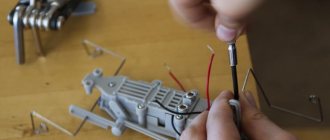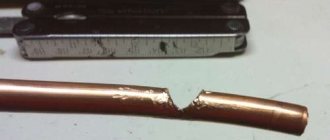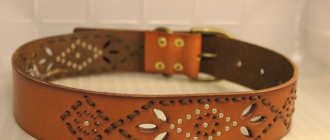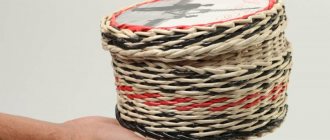How to sharpen a hacksaw yourself
A hacksaw for wood is one of the “eternal” values.
But, in order for a hand saw to always perform its functions, it must be sharpened correctly.
This is where basic knowledge about the type of cutting edge and its features will come in handy.
Of the existing methods, we will consider the safest and most popular ones, using available tools and available for home use.
Video description
The process of sharpening a hacksaw with a grinder is shown in the video:
The operation of restoring a hand saw using an angle grinder is a more painstaking job than sharpening a chainsaw. However, the process is still not too difficult, but only an experienced master can carry it out efficiently.
Using a grinder allows you to reduce sharpening time by almost half compared to using a file. After all, with a hand tool you need to perform synchronous movements and constantly control the amount of material removed from each tooth.
Why sharpen and when?
With constant use, the teeth lose their sharpness, the cutting edges wear out, deteriorating the quality of the cut and increasing the time it takes to complete the task.
Buying a new one will not correct the situation for long, and it will take no more than half an hour to restore the old canvas.
Timely sharpening of the hacksaw will restore the cutting ability of the incisors, and will always allow you to have a working tool at hand.
It is worth correcting the sharpness of the cutting edges at the first signs of wear, which can affect local areas and the entire working surface.
The dimensions of the cutter set also change, and this leads to jamming during operation.
Basic parameters of hand tools for cutting wood
A hacksaw is one of the most necessary tools in every man's inventory. This device allows you to easily change the dimensions of wood and plastic lumber. Using a hacksaw, you can perform a lot of operations in construction, cut branches in the garden, shorten fence poles, and so on.
A hand saw is used to work with lumber
But when purchasing such a seemingly simple tool, not everyone thinks about how to make the right choice and what criteria need to be taken into account. A hacksaw has its own special parameters that can affect the quality of work. There are four basic parameters when choosing a hacksaw: blade length, tooth size, steel type and handle type.
Blade length
For ease of use, the length of the hacksaw blade is chosen so that it is twice the size of the material at the cut site. This allows you to effectively remove sawdust during work due to the fact that all the teeth of the blade will come out of the board/log. In addition, this ratio of the size of the hacksaw and lumber contributes to a greater range of hand movement. This, in turn, takes much less effort. In construction, a universal hacksaw with a blade length of 45–50 centimeters is most often used. To work with small bars and boards, a blade 30–35 centimeters long will be sufficient.
Tooth size
This is perhaps the most important parameter. After all, the speed and accuracy of the cut depends on the size of the tooth. The number of teeth per inch of blade is usually denoted by the TPI coefficient. To work more accurately with the material, it is necessary to use a hacksaw with a high TPI coefficient, that is, with a large number of teeth. When choosing a blade with a TPI of at least 7–9, and a distance between teeth of no more than 2–4 mm, the surface at the cutting site will be smoother and without torn edges. For working with large beams and garden trees, a blade with a TPI of 3–6 and a tooth spacing of over 4 mm will work well. Using such a hacksaw will reduce the effort required and increase the speed of cutting the working material.
Tooth pitch correspondence table
| 1 TPI = 25.5mm | 10 TPI = 2.5mm |
| 2 TPI = 12mm | 11 TPI = 2.3mm |
| 3 TPI = 8.5mm | 12 TPI = 2mm |
| 4 TPI = 6.5mm | 13 TPI = 2mm |
| 5 TPI = 5mm | 14 TPI = 1.8mm |
| 6 TPI = 4mm | 17 TPI = 1.5mm |
| 7 TPI = 3.5mm | 19 TPI = 1.3mm |
| 8 TPI = 3mm | 22 TPI = 1.1mm |
| 9 TPI = 2.8mm | 25 TPI = 1mm |
Sharpening teeth
The usual triangular shape of hacksaw teeth is taken as standard. The teeth are made in the form of an acute triangle or isosceles, depending on the purpose of the cut. Such a blade can be sharpened with particular ease by repeating all the angles of the teeth. This blade can be used for both longitudinal and transverse cuts to avoid rough notches.
The teeth of a classic hacksaw are made in the shape of a triangle and can be sharpened
Video: self-sharpening hacksaw teeth for wood
But modern hacksaws, unlike classic ones, have hardened teeth with a non-standard trapezoidal shape. Such saws are endowed with increased strength and are resistant to wear. Their steel cannot be sharpened, and it is very difficult to maintain all the angles of the sharpened teeth.
Modern hacksaws are made with hardened teeth in the shape of a trapezoid.
Steel type
High-grade stainless steel is most often used to produce hacksaw blades. Typically, wood saws are made of steel with a hardness of HRC45. Very often, manufacturers combine steel in the canvas. In a hacksaw with a combined blade, the majority is also made of steel 45, but the cutting part is made of steel 55 and 60. When the cutting edge is hardened, wear resistance increases. This type of tool can be easily distinguished from a regular hacksaw by its dark, hardened teeth.
The ease of use of the saw depends on the correct choice of saw handle. Handles are made of wood or plastic. A very important point is that the surface at the grip site should be such that the hand does not slip. This can be eliminated by scarring the handle or covering it with a rubber layer. The hacksaw can be either a classic cast saw or with a reversible blade. The latter allows you to replace the canvas, which is very convenient.
How to determine when it’s time to sharpen a hacksaw?
How to determine when it's time to sharpen the teeth of the tool.
An experienced owner knows when and how to sharpen a hacksaw, but it is not difficult for the average person to determine this point on their own. As a rule, the sound produced during operation and the uniformity of the color of the cutting edge change.
Sharp cutters are characterized by uniform wear of the cutting edge.
The following signs indicate the need to “correct” the saw:
• sawing is difficult and uneven; • the cut is uneven; • the blade often gets stuck; • it becomes difficult to maintain a given trajectory.
In addition, a dull hacksaw often gets stuck and requires a lot of effort to complete the process.
Classification
Hand saws for wood come in a variety of configurations. Hence there are a large number of different models. The following types of hand saws are distinguished:
- classical. This type is the main one and almost every man has it. Such a saw can have a blade of different lengths with a different number of teeth. Most often, the tool has replaceable blades included in the kit upon purchase.
- narrow. This type of saw is also called a circular saw. It is named so because it helps to cut lines of various shapes, and very neat and clear ones. In addition, it is used to create through round and square holes. The file is quite narrow, has a large number of teeth, which can be located either on one working plane or on two. When working with such a saw you need to be careful. An uncertain movement can turn the blade in the other direction, for this reason, when choosing a hacksaw with a narrow blade, you need to choose high-quality hard steel that will not bend during operation
- with a butt. This hacksaw has a stiffening rib (shank), which does not allow the blade to bend during the cutting process. Consequently, the tool will not be able to make a cut below the width of the working part of the saw. This tool has a comfortable handle at an angle of 450 to the blade. This saw is easy to work with
- onion. In plumbing, a bow saw is an indispensable assistant. It is necessary in the process of cutting rough parts of the trunk, knots, as well as for cutting shapes from plywood and other wood materials. It can also be used to cut wood along and across the grain. The scope of use of a bow saw is so wide that it can become a substitute for a small woodworking machine. However, do not forget that the blade may fly off the mount or break during cutting.
- reward. A saw with an award will require a lot of effort from the master. This tool is similar to a plane. It has two handles. This saw is used for cutting grooves and tenons, and the depth of the holes and recesses can be made of different sizes. It can be used for rocks of any hardness
- folding. You can take this mechanical hacksaw with you on a hike or on vacation. Its main advantages: compactness, lightness, safety when folded. It has fine teeth and a short, pointed blade.
How to sharpen a hacksaw with your own hands
How to sharpen a hacksaw yourself if the need arises?
First you need to decide what material the work cloth is made of.
Ordinary steel can be corrected independently, but teeth with pobeditovy tips can only be processed on specialized industrial machines.
Some craftsmen, at their own peril and risk, undertake to sharpen a hacksaw using a grinder - but this is an unreliable and dangerous method.
To tidy up an ordinary manual hacksaw for wood at home, you will need to determine the shape of the teeth, prepare everything you need, and be sure to follow safety precautions.
How to cut with a two-handed saw alone
It often turns out that it is difficult to find a partner for sawing, so it becomes necessary to use the tool alone. It is impossible to do this without first modifying the saw, so it remains to figure out how to turn a two-handed hacksaw into a one-handed one, while maintaining the length of the blade. There is a way out, and it is quite simple - turn a flexible hacksaw into a rigid bow saw. All you need to do is make a frame.
- The first way to make a frame is to attach a beam or a narrow board to the existing handles on top with self-tapping screws. At this point, the manufacture of a long saw for hand sawing can be considered complete. The disadvantage of homemade products is that the blade will vibrate, so if you want to get a more reliable tool, you should choose the second option
- The two-handed saw uses two wooden handles that are removable. In the cylindrical holes on the canvas, it is necessary to install two elongated sticks, between which a rail of the required length should be placed crosswise. In the upper part, parallel to the rail, pull a rope, which ensures tension of the web. As a result, you can work the device alone without a partner, adjusting the degree of tension
If you plan to use the hacksaw for work yourself, then the frame can be welded from metal pipes. This design will be more reliable and will last no less than the tool blade. The principle of the conversion is simple and uncomplicated, so if you have accumulated a bunch of thick logs, then it’s time to cut them with a two-handed hacksaw alone.
This is interesting!
You can buy a crosscut saw, since modern manufacturers continue to produce this type of device, allowing themselves to modernize it.
Instead of primitive handles in the form of cylindrical bars, full-fledged handles are used, as on ordinary hand hacksaws. https://youtube.com/watch?v=8dZ5o6lG3xI%3F
General requirements for sharpening
Not every garage or workshop has a special machine for sharpening hacksaws, but it won’t hurt to sharpen the tool yourself.
There are, of course, exceptions - hardened teeth cannot be sharpened.
Diamond drills and other tricks will not help.
This saw has an increased service life and must not be repaired, but replaced with a new one.
It is easy to identify hardened steel - it is distinguished by its black color with a blue tint.
A grinder or a file and a needle file are usually used as a sharpener for a hacksaw.
A prerequisite is to first carry out the correct setting of the teeth, because the thickness of the hacksaw blade affects the width of the cut, so the edges must be bent to the required width.
Sharpening instructions
First you need to prepare the equipment necessary for work:
To make sharpening better, you can prepare additional tools:
- A device that allows you to mount the saw at the required angle.
- Locksmith's hammer.
Wiring
Before returning the sharpness to the saw, you need to adjust the teeth, that is, move them apart. Setting is the installation of cutting teeth at a certain angle relative to the blade and each other. If you look at the set saw, you can see that they, alternating, deviate to the right and left from the blade plate itself. This configuration gives the hacksaw freedom to make deep cuts. It doesn’t get stuck because it doesn’t touch the walls with its entire plane.
To set the correct angle for each tooth “by eye”, you need solid experience, which not every carpenter has. It comes after many dozens of sharpened saws. For less experienced carpenters, there is a tool called a setting tool. Its most primitive version is a flat steel plate with a slot. A hacksaw is inserted into this gap with a minimum gap, under tension.
The wiring process looks like this:
- Secure the hacksaw in a vice like this. It is necessary to ensure that the teeth protrude 2 cm above the jaws.
- The teeth are clamped in the groove and then bent in the middle.
- First you need to bend all the even teeth in one direction, then bend the odd ones in the opposite direction.
- At the end, you can spread the jaws of the vice according to the calculated width of the spread and try to pass the saw between them.
- An excessively bent tooth will hit the vice. Use pliers to bend it a little further.
Adjustment of teeth height
All cutting lugs must be the same size to ensure that sawing performance is not compromised.
Longer teeth experience greater stress and wear out faster, while shorter teeth do not even touch the wood. Pulling the canvas becomes jerky, uneven, and more effort is wasted. The accuracy of the cut deteriorates, the cut surface becomes rougher.
Adjustments are made before sharpening begins. To make sure that none of the teeth protrude, you can do this: press the canvas against a sheet of paper placed on the table.
The tops of the teeth will be imprinted on the sheet, and the gaps in this pattern will allow you to adjust their height. To do this, hold the saw in a bench vise and use a file to file down the teeth that are too long.
Direct sharpening
To return the teeth to their former sharpness, a whetstone used to sharpen kitchen knives is not suitable. You need a special tool: a file with a triangular cross-section or a needle file. It is very good if you have several files with different sections and cut pitches: this will allow you to process each tooth perfectly.
Sharpening stages:
- Hold the file by the handle with one hand and place the other on the end of the tool.
- Decide on the sharpening angle. Usually it is 15-30 °. You can determine it by eye, with a protractor, or use simple equipment. Shape a block of wood into an isosceles triangle with angles of 90, 60 and 30 degrees, then use it as a measuring stick.
- Sharpen the left cutting edges of the even (farthest from you) teeth. Each requires an equal number of file passes to remove the same amount of chips. The pressure on the tool should be equal.
- Turn the hacksaw over to the other side, then sharpen the left edges of the even-numbered teeth again.
- Sharpen the tops of the teeth.
- Do not forget to control the sharpening angle using a whetstone.
The process seems very simple, albeit monotonous, but there are a number of nuances:
- The saw must be secured very tightly in the vise for safety reasons. Do not be afraid to damage the metal of the blade with strong compression.
- The work area should be well lit to make it easier to determine angles and sharpness.
- The metal is removed only when the file moves away from the carpenter.
- The more dull the saw, the larger the notches on the file can be, but to fine-tune the teeth you should always use a file with small notches.
- When fixing the tool in a vice, push it between the jaws as deep as possible. To prevent the hacksaw from swinging outward, only the teeth should remain.
- During the work process, there will inevitably be burrs on the sharpened edges. To remove them, just rub the metal with a fine-grained abrasive (sandpaper).
- To check the quality, you need to carefully examine the teeth in the light. They should shine.
Sharpening quality improvements
The classic option that anyone can use was discussed above. There is a way to make the sharpening process more efficient and easier.
When using a multi-axis vice with a rotating frame, you can fix the blade so that you only have to move the file in the horizontal plane.
Necessary tool
Sharpening a hacksaw using a grinder or grinder requires certain skills.
It is much safer and easier to sharpen a hacksaw mechanically.
Before you begin, prepare a vice or clamp, calipers, hammer and other necessary tools:
Crosscut saws are sharpened at an angle of 60 degrees using a triangular fine file.
Longitudinal with an angle of less than 60 degrees - use a large needle file or diamond file with fine abrasive.
For a mixed type, you will need a coarsely cut file or a finely cut diamond file.
For this operation, a special sharpening device is useful - a wooden block with a cut-out socket to protect your hands from cuts.
NOTE:
To sharpen a hacksaw using a grinder, you will need a cutting wheel with a thickness of 1.2 to 1.4 mm, with a diameter of 115 or 125 mm. The angle grinder must have a speed adjustment in the range of 5000 - 8000 per minute. Installing protection is a prerequisite for using this method. As a rule, a homemade shield made of transparent plastic is used.
Wood saw sharpening technology
Proper sharpening of a hacksaw should preserve the working profile of the teeth.
It is determined by the following parameters:
• pitch and height; • point angle; • radius of curvature.
The sharpening angle can be set in the range from 30 to 60 degrees, and depends on the material.
So, for soft wood, 50 degrees will be optimal.
It is important to secure the blade correctly in the vice - do not clamp it too hard, as the steel will vibrate under the file.
Using a workbench and a clamp, you can conveniently secure the hacksaw.
Sharpening is done by alternating double-sided sharpening - first, one row is passed along the left edges of all teeth.
Then the tool is turned over and the passage along the right half of the cutters is repeated.
The one-way method is not used for straightening hand saws - it is applicable only to certain types of knives.
Recommendations
Wood saws are classified not only according to the purpose of use, they can also differ according to other criteria.
- Canvas length. The comfort of the worker depends on how many teeth are arranged on the saw blade in a row, since with a longer length fewer saws are made, and a tooth is hammered on such a saw with less intensity. There is a general law that states that the length of a hacksaw blade for wood should be twice as long as the object being sawed.
- Teeth size. The size directly affects the cutting time and is inversely proportional to its quality. A small hacksaw makes high-quality and clean cuts, but at a lower speed and with the application of greater forces. A saw with a large tooth spends less time cutting, but produces a ragged edge and a rough surface. Typically, the parameter of the teeth of hacksaws for wood from foreign manufacturers is TPI (teeth per inch or “teeth per inch”), that is, the more cutting edges are located on 1 inch of the blade, the larger the TPI value, the smaller the tooth.
It is worth paying attention to the inches to millimeters conversion table
Tooth shape. This parameter determines how the cut will proceed relative to the wood fiber of the type of tree and the vectors of the applied forces (from oneself or towards oneself). In addition, there are hacksaws for universal sawing, which have different types of teeth.
Grade of steel from which the hacksaw blade is made
Steel is classified according to many parameters, but it is worth paying attention only to how the steel was processed - hardened, not hardened, or combined (not the entire hacksaw is hardened, but only its teeth).
When sharpening teeth, the hacksaw blade is clamped so that no more than a centimeter of the tooth protrudes above the vice. When sharpening, it is recommended to choose a triangular file/needle section. To ensure proper quality, when sharpening you need to follow the following sequence:
- sharpen the left edge of each even (farthest from the worker) tooth;
- reinstall the canvas by rotating it 180 degrees;
- sharpen the left edge of each even tooth again, which will again be in the far row;
- finish the cutting edge and sharpen the teeth.
It is worth paying attention that longitudinal or universal saws are fixed at an angle of 90 degrees. When sharpening, use a diamond-shaped file
Work with it must be carried out exclusively horizontally. As a result, sharpened edges sometimes become nicked. Such burrs should be smoothed with a file with the finest notch or an abrasive stone with minimal grain size.
How well the hacksaw teeth are sharpened is checked as follows:
carefully run your hand along the canvas - if the skin feels a sharp edge and there are no burrs or scuffs - everything is in order; in terms of shade - well-sharpened edges do not glare when light falls on them, they should be matte; test sawing - the hacksaw should go straight, the sawn material should have a smooth, even surface, there should be no frayed fibers; The finer the cut the tool has, the sharper the saw will be sharpened.
It is worth paying attention to the following advice from professionals:
- It is recommended for use only high-quality tool sets that are used exclusively for sharpening saw teeth;
- for each tooth there should be an equal number of movements with a file/needle file; this rule applies even if there is an impression that the passage needs to be repeated;
- during one pass, it is prohibited to change the hand and the angle at which the tool moves until one side of the hacksaw blade has been completely passed;
- It is forbidden to change the side of the file/needle, that is, each side must be passed with the same side of the tool;
- Observing the correct geometry of each cutting segment of a wood hacksaw gives significant positive effects - durability of use, wear resistance, low loss of material waste, and an even cut.
We can say that it is not so difficult to process (spread and sharpen the teeth) such a simple tool as a hacksaw at home. By following the general rules, having certain practical skills and the simplest devices, it is quite possible to give the tool a second life with your own hands and avoid additional costs by buying a new joiner's saw.
How to sharpen a hacksaw at home, see the following video.
How to properly sharpen a hacksaw with a file
Using a file is still relevant today, so let’s try to figure out how to properly sharpen a hacksaw at home.
Let's start by installing the canvas.
It must be secured, as already mentioned above, in a clamp or vice.
The jaws of the vice must be made of wood, with the width of the “jaws” not less than 200 mm.
The movement of the file should be uniform, and pressure on the teeth should only be applied when moving “forward”.
It is necessary to move the hand with the tool to the starting point freely, without force on the incisors.
In one working pass, a uniform layer of metal is removed, this will preserve the pitch, height and profile of the edge.
The sharpness of the cutter can be reduced due to the formation of burrs on the surface and irregularities after passing the abrasive.
A file cannot sharpen a hacksaw perfectly, but you can get high quality - after sharpening, the smallest file or needle file and whetstone will come in handy.
Burrs are removed by selective grinding with a fine abrasive, and the edges are leveled with a wet whetstone along the side base of the blade.
When you set out to sharpen a hacksaw correctly, pay attention to maintaining the tops of the teeth.
The same height of the cutters and correct setting affect the wear resistance of the tool and the quality of the cut.
The nuances of sharpening a hand saw
When sharpening a hand saw for wood, each master follows a number of rules:
- The hacksaw is most securely attached to a workbench or other fixed base when using a vice or clamps. This will allow you to sharpen the saw efficiently and reduce the likelihood of injury.
- The work area is well illuminated so that even very small teeth can be clearly seen.
- Movements with a sharpening tool are performed exclusively in one direction if the process is carried out with a file.
In addition, to quickly check the quality of sharpening, use sunlight. When hit by rays, the teeth begin to shine if the sharpening process is carried out correctly.
Hacksaw teeth set
The movement of the blade must be free, for which the saw teeth are set apart by the same amount.
To reduce the coefficient of friction and the clamping of the hacksaw in the cut, its width must be greater than the thickness of the working blade, otherwise the metal heats up and expands, which leads to the saw jamming.
The teeth of the hacksaw are set by bending the cutters to the sides.
Using pliers does not allow you to obtain the same angle of inclination - with such a tool you can only cut firewood.
To spread the cutters evenly and get an even, neat cut, use a homemade device for setting the teeth.
To make it, you need a metal die of arbitrary shape with a thickness of 2-3 mm.
In a simple version, several slits are made to indicate the thickness of the canvas.
The tooth is grabbed into the hole and bent until the selected stop is reached.
In the second version, a cut is cut into the plank with a metal file, and two holes are drilled to install the limiter.
Rotating the sector to the sides allows you to adjust the bend angle.
The figure shows a simple model and wiring with a stop.
The design of the device is intuitively easy to manufacture and use.
It is necessary to take into account that the width of the bend has its own parameters.
Saw layout
Tooth setting pliers
Tooth setting pliers are a good tool. Its cost can be compared with the price of a hand saw: 300-500 rubles. It is very convenient to use; the saw tooth moves to the side as needed.
Wiring for a hacksaw. It’s also a good thing and inexpensive—the average price is around 100 rubles. The design is simple: several slots and an adjustable angle gauge. The tooth is inserted into a slot of suitable size, and the setting is carried out by applying pressure to the handle. The set protractor ensures uniform distribution.
Wiring for hacksaw
You don’t have either one at home, but don’t want to run to the store? Then you can use the old-fashioned method - it has been used since the beginning of time. All you need is an ax and some dexterity so as not to damage your hands (for people who are not good with tools, do not use this method - it is dangerous!).
The technology is simple : the blade is inserted between two teeth and by turning the ax, the teeth bend to the sides.
Setting teeth with an ax
The saw can also be routed using a self-tapping screw. It's more secure. For this you need a long screw - to make it more convenient to hold. It needs a little modification before work. You need to grind off its cap a little on one side to make it flat. This is necessary so that when it is applied to the tooth, it does not slip off and deform the latter.
The hacksaw should lie flat on soft wood (pine, spruce). Holding the self-tapping screw by the leg, apply the head to the tooth and hit it with a hammer. The tooth bends. The operation is performed through the tooth. Afterwards, the saw blade is turned over and the operation is repeated in the same way.
Setting teeth using a self-tapping screw
Requirements for the setting of hacksaw teeth
When bending the cutters one at a time on both sides of the canvas, maintain a certain value that can be set on a homemade device.
The width of the wiring depends on the type of wood.
Soft and damp wood requires a larger angle of inclination than dry wood.
As a rule, hand tools work effectively with an average value of 0.2-0.3 mm.
At the same time, the total value should not exceed the width of the canvas.
In addition, the same nature of the bend on each side is observed.
The wiring for the hacksaw is checked visually or using a caliper.
Pay attention to the size of the tooth - the height of the incisor is especially important.
How to check if your saw is sharpened correctly
After finishing the process of sharpening a tool for working with wood, it is worth checking each tooth of the hacksaw against the light. If shine is visible, the sharpening was done correctly; if not, then you should go over the “suspicious” teeth again. You should also check whether the teeth on the blade are the same height. If they are higher or lower, this will lead to lower cutting quality and blade wear will be unevenly distributed.
Is the saw sharpened correctly?
As a result, when sharpening a hacksaw blade, you need to adhere to the following recommendations:
- The blade must be securely secured in a vice without the slightest sign of slipping during the process.
- The workplace should be as illuminated as possible; this will not only allow you to work normally with the tool, but will also protect your eyes from wearing glasses prematurely.
- The depth of the cut of the selected file depends only on the degree of dullness of the teeth - the duller, the more “powerful” the tool is needed.
- Sharpening of metal occurs only when moving away from you and only in one direction. This prevents hand injuries from accidentally touching the canvas during movement.
- After finishing sharpening, it is necessary to check the quality of the work performed, and in case of unevenness, it is better to correct it immediately than to suffer later in the process of sawing wood, especially hardwood.
On a note. When using a hacksaw, you should regularly pay attention to its performance. This will save effort, nerves and the tool will last a very long time if handled with care.
Any tool should be checked before and after completion of work. Safety first! If with a hand tool there will only be a cut at best, then with an electric one it can result in a lifelong injury. Therefore, it is recommended to inspect the instruments before use.
All the recommendations and warnings will help you properly sharpen any hand saw for working with wood, and you won’t have any problems determining when to do it.
Leveling the height of the links
All teeth must be the same height.
An uneven edge results in uneven loading and significantly reduces work efficiency.
Checking the height of the hacksaw teeth
It is necessary to check the height of the teeth before sharpening the tool.
To do this, place a sheet of plain paper on a hard and flat surface, and press the cutters tightly until a clear imprint is obtained.
If there are teeth protruding from the general row, traces of them will be reflected on the print.
If there are higher teeth, they are carefully cut down with a flat file to the general level.
Varieties
In common parlance, the two-handed saw was called “Friendship-2”, as it was designed for work by two people. Among all similar hand-held devices, it has the largest dimensions. The modern construction industry produces several varieties of this tool, which differ in size and sharpening shape of the cutting teeth. There are 4 main saw length standards:
- 1500 m;
- 1750 m.
Today, many companies produce such saws from different types of steel, but all have standard sizes. The length of the teeth, regardless of the dimensions of the blade, is 20 mm, but their shape can be different. On short models up to one and a half meters, the cutting teeth have a classic triangular shape. Long versions (1500 and 1750 mm) are equipped with M-shaped teeth, between which there are 2-3 regular triangular ones. Such a complex configuration of teeth on long saws is necessary so that during sawing the sawdust does not linger in the slot, but comes out. In short versions of the tool, this is not necessary, since they are used only for cutting small wooden elements.
The sharpening angle of the working cutting teeth for all types of two-handed saws is initially the same - 70 degrees, but each master changes it at his own discretion. For example, to work with soft wood in the summer, it is better to sharpen the teeth to 35 degrees. In winter, if dry logs or trees are being sawed, the angle is adjusted to 50 degrees, when working with raw material - up to 60. But these are conditional indicators, to a large extent everything depends on the specific type of wood species, work conditions and the personal preferences of the master.











